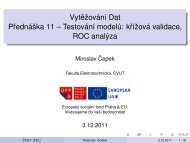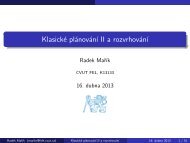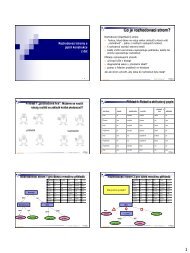Evolutionary Algorithms: Introduction Jiˇr´ı Kubal´ık Department of ...
Evolutionary Algorithms: Introduction Jiˇr´ı Kubal´ık Department of ...
Evolutionary Algorithms: Introduction Jiˇr´ı Kubal´ık Department of ...
Create successful ePaper yourself
Turn your PDF publications into a flip-book with our unique Google optimized e-Paper software.
<strong>Evolutionary</strong> <strong>Algorithms</strong>: <strong>Introduction</strong><br />
Jiˇrí Kubalík<br />
<strong>Department</strong> <strong>of</strong> Cybernetics, CTU Prague<br />
http://cw.felk.cvut.cz/doku.php/courses/a4m33bia/start
pContents<br />
1. <strong>Introduction</strong> to <strong>Evolutionary</strong> <strong>Algorithms</strong> (EAs)<br />
Pioneers <strong>of</strong> EAs,<br />
Simple Genetic Algorithm (SGA),<br />
Areas for EA’s applications,<br />
SGA example: Evolving strategy for an artificial ant problem.<br />
Schema theory – a schema, its properties, exponential growth equation and its consequences.<br />
2. Genetic Programming (GP) and Grammatical Evolution (GE)<br />
Tree representation, closure condition, ’strong typing’,<br />
Application <strong>of</strong> GP to the artificial ant problem,<br />
Other examples.<br />
3. Multi-objective EAs (MOEAs)<br />
Multi-objective optimization<br />
Concept <strong>of</strong> dominance and Pareto-optimality,<br />
NSGA, NSGA-II, SPEA, SPEA2.<br />
<strong>Evolutionary</strong> <strong>Algorithms</strong>: Intro
4. Real-coded EAs<br />
Evolution strategies,<br />
Crossover operators for real-coded representation,<br />
Differential evolution.<br />
5. EAs for dynamic optimization problems<br />
6. Swarm Intelligence<br />
Ant Colony Optimization,<br />
Particle Swarm Optimization.<br />
<strong>Evolutionary</strong> <strong>Algorithms</strong>: Intro
p<strong>Evolutionary</strong> Programming<br />
Lawrence J. Fogel in 1960: <strong>Evolutionary</strong> programming (1960)<br />
The goal is to evolve an ”intelligent behavior” that would exhibit the ability to (1) predict one’s<br />
environment, coupled with (2) a translation <strong>of</strong> the predictions into a suitable response in light <strong>of</strong><br />
the given goal.<br />
the environment was described as a sequence <strong>of</strong> symbols taken from a finite alphabet,<br />
finite state machines (FSMs) were used for representing the required behavior.<br />
Five modes <strong>of</strong> mutation<br />
add a state,<br />
delete a state,<br />
change the initial state,<br />
change an output symbol,<br />
change a next-state transition.<br />
FSM<br />
D. B. Fogel and K. Chellapilla: Revisiting <strong>Evolutionary</strong><br />
Programming, Aerospace/Defense Sensing and controls.<br />
<strong>Evolutionary</strong> <strong>Algorithms</strong>: Intro
pEvolution Strategies: Optimization <strong>of</strong> a Two-Phase Nozzle<br />
Ingo Rechenberg and Hans-Paul Schwefel: Evolution Strategy (early 1960s)<br />
The task was to determine the internal shape <strong>of</strong> a two-phase jet nozzle with maximum thrust<br />
under constant starting conditions.<br />
The nozzles were built <strong>of</strong> conical pieces such that no discontinuity within the internal shape<br />
was possible.<br />
Every nozzle shape could be represented by its overall length and the inside diameters at the<br />
borders between the segments (every 10mm).<br />
(1+1) Evolution Strategy using mutations <strong>of</strong> the following forms:<br />
Add new segment to the nozzle at positions chosen at random.<br />
Duplicate an existing segment.<br />
Delete a randomly chosen segment.<br />
Vary diameters <strong>of</strong> a randomly chosen segment.<br />
−→<br />
http://ls11-www.cs.uni-dortmund.de/people/kursawe/Demos/Duese/dueseGIFE.html<br />
<strong>Evolutionary</strong> <strong>Algorithms</strong>: Intro
p<strong>Evolutionary</strong> <strong>Algorithms</strong>: Characteristics<br />
:: EA are stochastic optimization algorithms<br />
Stochastic – but not random search,<br />
Use an analogy <strong>of</strong> natural evolution<br />
− genetic inheritance (J.G. Mendel) – the basic principles <strong>of</strong> transference <strong>of</strong> hereditary factors<br />
from parent to <strong>of</strong>fspring – genes, which present hereditary factors, are lined up on<br />
chromosomes.<br />
− strife for survival (Ch. Darwin) – the fundamental principle <strong>of</strong> natural selection – is the<br />
process by which individual organisms with favorable traits are more likely to survive and<br />
reproduce.<br />
Not fast in some sense – population-based algorithm,<br />
Robust – efficient in finding good solutions in difficult searches.<br />
<strong>Evolutionary</strong> <strong>Algorithms</strong>: Intro
pEA: Vocabulary<br />
:: Vocabulary borrowed from natural genetics<br />
Individual (chromosome + its quality measure ”fitness value”) – a solution to a problem.<br />
Chromosome – entire representation <strong>of</strong> the solution.<br />
Fitness – quality measure assigned to an individual, expresses how well it is adapted to the<br />
environment.<br />
Gene (also features, characters) – elementary units from which chromosomes are made.<br />
− each gene is located at certain place <strong>of</strong> the chromosome called locus (pl. loci),<br />
− a particular value for a locus is an allele.<br />
example: the ”thickness” gene (which might be at locus 8) might be set to allele 2,<br />
meaning its second-thinnest value.<br />
Genotype – what’s on the chromosome.<br />
Phenotype – what it means in the problem context (e.g., binary sequence may map to<br />
integers or reals, or order <strong>of</strong> execution, etc.).<br />
<strong>Evolutionary</strong> <strong>Algorithms</strong>: Intro
pRepresentation<br />
:: Problem can be represented as<br />
binary string –<br />
real-valued string –<br />
string <strong>of</strong> chars –<br />
or as a tree<br />
or as a graph, and others.<br />
<strong>Evolutionary</strong> <strong>Algorithms</strong>: Intro
pEvaluation Function<br />
:: Objective (Fitness) function<br />
the only information about the sought solution the algorithm dispose <strong>of</strong>,<br />
must be defined for every possible chromosome.<br />
:: Fitness function may be<br />
multimodal,<br />
discrete,<br />
multidimensional,<br />
nonlinear,<br />
noisy,<br />
:: Fitness does not have to be define analytically<br />
simulation results,<br />
classification success rate.<br />
:: Fitness function should not be too costly!!!<br />
multiobjective.<br />
<strong>Evolutionary</strong> <strong>Algorithms</strong>: Intro
pExample: Coding & Evaluation<br />
:: Function optimization<br />
maximization <strong>of</strong> f(x, y) = x 2 + y 2 ,<br />
parameters x and y take on values from interval < 0, 31 >,<br />
and are code on 5 bits each.<br />
<strong>Evolutionary</strong> <strong>Algorithms</strong>: Intro
p<strong>Evolutionary</strong> Cycle<br />
<strong>Evolutionary</strong> <strong>Algorithms</strong>: Intro
pIdealized Illustration <strong>of</strong> Evolution<br />
Uniform sampled population. Population converged to promising regions.<br />
<strong>Evolutionary</strong> <strong>Algorithms</strong>: Intro
pInitialization<br />
:: Random<br />
randomly generated solutions,<br />
no prior information about the shape <strong>of</strong> the sought solution,<br />
relies just on ”lucky” sampling <strong>of</strong> the whole search space by a finite set <strong>of</strong> samples.<br />
:: Informed (pre-processing)<br />
(meta)heuristic routines used for seeding the initial population,<br />
biased random generator sampling regions <strong>of</strong> the search space that are likely to contain the<br />
sought solutions,<br />
+ may help to find better solutions,<br />
+ may speed up the search process,<br />
– may cause irreversible focusing <strong>of</strong> the search process on regions with local optima.<br />
<strong>Evolutionary</strong> <strong>Algorithms</strong>: Intro
pReproduction<br />
:: Models nature’s survival-<strong>of</strong>-fittest principle<br />
prefers better individuals to the worse ones,<br />
still, every individual should have a chance to reproduce.<br />
:: Roulette wheel<br />
probability <strong>of</strong> choosing some solution is directly<br />
proportional to its fitness value<br />
:: Other methods<br />
Stochastic Universal Sampling,<br />
Tournament selection,<br />
Reminder Stochastic Sampling.<br />
<strong>Evolutionary</strong> <strong>Algorithms</strong>: Intro
pReproduction: Premature Convergence & Stagnation<br />
:: Two (strongly related) important issues in the evolution process<br />
population diversity,<br />
selective pressure.<br />
:: Premature convergence – a premature loss <strong>of</strong> diversity in the population with the search<br />
converging to a sub-optimal solution.<br />
early stages <strong>of</strong> the evolution search process.<br />
:: Stagnation – ineffective search due to a weak selective pressure.<br />
later stages <strong>of</strong> the evolution search process.<br />
<strong>Evolutionary</strong> <strong>Algorithms</strong>: Intro
pPremature Convergence<br />
<strong>Evolutionary</strong> <strong>Algorithms</strong>: Intro
pStagnation<br />
<strong>Evolutionary</strong> <strong>Algorithms</strong>: Intro
pHow to Deal with it?<br />
:: Balance between exploration and exploitation.<br />
How to achieve the optimal selective pressure during the whole evolution search?<br />
:: Options<br />
scaling techniques,<br />
proper selection mechanisms,<br />
fitness sharing and crowding,<br />
. . . .<br />
<strong>Evolutionary</strong> <strong>Algorithms</strong>: Intro
pScaling<br />
:: Linear scaling – adjustment <strong>of</strong> the fitness values distribution in order to get desired selection<br />
pressure<br />
σ = fmax/favg<br />
The actual chromosomes’ fitness is scaled as<br />
Parameters a and b are selected so that<br />
the average fitness is mapped to itself, and<br />
f ′ i = a · fi + b<br />
the best fitness is increased by a desired multiple <strong>of</strong> the average fitness.<br />
Typical value <strong>of</strong> σ is from (1.5, 2.0)<br />
<strong>Evolutionary</strong> <strong>Algorithms</strong>: Intro
pEffect <strong>of</strong> Linear Scaling<br />
<strong>Evolutionary</strong> <strong>Algorithms</strong>: Intro
pTournament Selection<br />
:: Tournament selection – the best out <strong>of</strong> n randomly chosen individuals is selected.<br />
n is the size <strong>of</strong> the tournament,<br />
rank-based method – absolute differences among individuals do not count.<br />
<strong>Evolutionary</strong> <strong>Algorithms</strong>: Intro
pRank Selection<br />
:: Rank selection – fitness <strong>of</strong> the individual is calculated based on the rank <strong>of</strong> the individual in<br />
the population according to the formula<br />
f ′ i = P opSize − rank(i) + shift<br />
where shift is the fitness <strong>of</strong> the worst individual in the population.<br />
<strong>Evolutionary</strong> <strong>Algorithms</strong>: Intro
pGenetic Operators: Crossover<br />
:: Idea<br />
given two well-fit solutions to the given problem, it is possible to get a new solution by properly<br />
mixing the two that is even better than both its parents.<br />
:: Role <strong>of</strong> crossover<br />
sampling (exploration) <strong>of</strong> the search space<br />
Example: 1-point crossover<br />
<strong>Evolutionary</strong> <strong>Algorithms</strong>: Intro
pGenetic Operators: Mutation<br />
Role <strong>of</strong> mutation<br />
preservation <strong>of</strong> a population diversity,<br />
minimization <strong>of</strong> a possibility <strong>of</strong> loosing some important piece <strong>of</strong> genetic information.<br />
Single bit-flipping mutation<br />
Population with missing genetic<br />
information<br />
0 0 1 1 0 0 0 1 1 0<br />
0 1 1 0 0 1 0 1 0 0<br />
0 0 0 1 1 0 1 0 1 1<br />
0 1 0 0 1 0 0 1 1 1<br />
0 1 1 0 0 0 0 1 0 1<br />
. . .<br />
0 1 0 0 1 1 0 1 0 0<br />
<strong>Evolutionary</strong> <strong>Algorithms</strong>: Intro
pReplacement Strategy<br />
Replacement strategy defines<br />
how big portion <strong>of</strong> the current generation will be replaced in each generation, and<br />
which solutions in the current population will be replaced by the newly generated ones.<br />
Two extreme cases<br />
Generational – the whole old population is completely rebuild in each generation (analogy<br />
<strong>of</strong> short-lived species).<br />
Steady-state – just a few individuals are replaced in each generation (analogy <strong>of</strong> longer-lived<br />
species).<br />
<strong>Evolutionary</strong> <strong>Algorithms</strong>: Intro
pApplication Areas <strong>of</strong> <strong>Evolutionary</strong> <strong>Algorithms</strong><br />
EAs are popular for their<br />
simplicity,<br />
effectiveness,<br />
robustness.<br />
Holland: ”It’s best used in areas where you don’t really have a good idea what the solution<br />
might be. And it <strong>of</strong>ten surprises you with what you come up with.”<br />
Applications<br />
control,<br />
engineering design,<br />
image processing,<br />
planning & scheduling,<br />
VLSI circuit design,<br />
network optimization & routing problems,<br />
optimal resource allocation,<br />
marketing,<br />
credit scoring & risk assessment,<br />
and many others.<br />
<strong>Evolutionary</strong> <strong>Algorithms</strong>: Intro
pMultiple Traveling Salesmen Problem<br />
Rescue operations planning<br />
Given N cities and K agents, find an optimal<br />
tour for each agent so that every city is<br />
visited exactly once.<br />
A typical criterion to be optimized is the<br />
overall time spent by the squad (i.e., the<br />
slowest team member) during the task execution.<br />
<strong>Evolutionary</strong> <strong>Algorithms</strong>: Intro
pArtificial Ant Problem<br />
Santa Fe trail<br />
32 × 32 grid with 89 food pieces.<br />
Obstacles<br />
− 1×, 2× strait,<br />
− 1×, 2×, 3× right/left.<br />
Ant capabilities<br />
detects the food right in front <strong>of</strong><br />
him in direction he faces.<br />
actions observable from outside<br />
− MOVE – makes a step and eats<br />
a food piece if there is some,<br />
− LEFT – turns left,<br />
− RIGHT – turns right,<br />
− NO-OP – no operation.<br />
Goal is to find a strategy that would navigate an ant through the grid so that it finds all the food<br />
pieces in the given time (600 time steps).<br />
<strong>Evolutionary</strong> <strong>Algorithms</strong>: Intro
pArtificial Ant Problem: GA Approach<br />
Collins a Jefferson 1991, standard GA using binary representation<br />
Representation<br />
strategy represented by finite state machine,<br />
table <strong>of</strong> transitions coded as binary chromosomes <strong>of</strong> fixed length.<br />
Example: 4-state FSM, 34-bit long chromosomes (2 + 4 × 8)<br />
<strong>Evolutionary</strong> <strong>Algorithms</strong>: Intro
pArtificial Ant Problem: Example cont.<br />
Ant behavior<br />
What happens if the ant ”hits” an obstacle?<br />
What is strange with transition from state 10<br />
to the initial state 00?<br />
When does the ant succeed?<br />
Is the number <strong>of</strong> states sufficient to solve the<br />
problem?<br />
Do all <strong>of</strong> the possible 34-bit chromosomes<br />
represent a feasible solution?<br />
<strong>Evolutionary</strong> <strong>Algorithms</strong>: Intro
pArtificial Ant Problem: GA result<br />
Representation<br />
32 states,<br />
453 = 64 × 7 + 5 bits !!!<br />
Population size: 65.536 !!!<br />
Number <strong>of</strong> generations: 200<br />
Total number <strong>of</strong> samples tried: 13 × 10 6 !!!<br />
<strong>Evolutionary</strong> <strong>Algorithms</strong>: Intro
pSchema Theory<br />
Schema theory (J. Holland, 1975) – tries to analyze effect <strong>of</strong> selection, crossover and mutation<br />
on the population’s genotype in order to answer the question: ”Why and How <strong>Evolutionary</strong><br />
<strong>Algorithms</strong> Work?”<br />
In its original form the schema theory assumes:<br />
binary representation,<br />
proportionate roulette wheel selection,<br />
1-point crossover and bit-flip mutation.<br />
<strong>Evolutionary</strong> <strong>Algorithms</strong>: Intro
pSchema theory<br />
:: Schema – a template, which defines set <strong>of</strong> solutions from the search space with certain specific<br />
similarities.<br />
consists <strong>of</strong> 0s, 1s (fixed values) and wildcard symbols * (any value),<br />
covers 2 r strings, where r is a number <strong>of</strong> ∗ used in the schema.<br />
Example: schema S ={11*0*} covers strings 11000, 11001, 11100, and 11101<br />
:: Schema properties<br />
Defining length δ(S) (compactness) – distance between first and last non-* in a schema<br />
(= number <strong>of</strong> positions where 1-point crossover can disrupt it).<br />
Order o(S) (specificity) – a number <strong>of</strong> non-*’s (= number <strong>of</strong> positions where simple bit<br />
swapping mutation can disrupt it).<br />
− Chromosomes are order l schemata, where l is length <strong>of</strong> chromosome (in bits or loci).<br />
− Chromosomes are instances (or members) <strong>of</strong> lower-order schemata.<br />
− How many schemata are matched by a string <strong>of</strong> length l?<br />
Fitness f(S) (quality) – average fitness computed over all covered strings.<br />
Example: S ={**1*01*0**}: δ(S) = 5, o(S) = 4<br />
<strong>Evolutionary</strong> <strong>Algorithms</strong>: Intro
pSchema Properties: Example<br />
:: 8-bit Count Ones problem – maximize a number <strong>of</strong> ones in 8-bit string.<br />
string fitness string fitness<br />
00000000 0 11011111 7<br />
00000001 1 . . . 10111111 7<br />
00000010 1 01111111 7<br />
00000100 1 11111111 8<br />
Assume schema Sa ={1*1**10*} vs. Sb ={*0*0****}:<br />
defining length: δ(Sa) = 7 − 1 = 6, δ(Sb) = 4 − 2 = 2<br />
order: o(Sa) = 4, o(Sb) = 2<br />
fitness <strong>of</strong> Sa: Sa covers 2 4 strings in total<br />
1 string <strong>of</strong> fitness 3<br />
4 string <strong>of</strong> fitness 4 f(Sa) = (1 · 3 + 4 · 4 + 6 · 5 + 4 · 6 + 1 · 7)/16<br />
6 string <strong>of</strong> fitness 5 f(Sa) = 80/16 = 5<br />
4 string <strong>of</strong> fitness 6<br />
1 string <strong>of</strong> fitness 7<br />
fitness <strong>of</strong> Sb: Sb = (1 · 0 + 6 · 1 + 15 · 2 + 20 · 3 + 15 · 4 + 6 · 5 + 1 · 6)/2 6 = 192/64 = 3<br />
Question: What would be a fitness <strong>of</strong> S ={*0*1****} compared to Sb?<br />
<strong>Evolutionary</strong> <strong>Algorithms</strong>: Intro
pSchema Theorem Derivation: Effect <strong>of</strong> Reproduction<br />
Let m(S, t) be number <strong>of</strong> instances (strings) <strong>of</strong> schema S in population <strong>of</strong> size n at time t.<br />
Question: How do schemata propagate? What is a lower bound on change in sampling rate <strong>of</strong><br />
a single schema from generation t to t + 1?<br />
Effect <strong>of</strong> fitness-proportionate roulette wheel selection<br />
A string ai is copied according to its fitness; it gets selected with probability<br />
pi = fi<br />
.<br />
fj<br />
After picking n strings with replacement from the population at time t, we expect to have<br />
m(S, t + 1) representatives <strong>of</strong> the schema S in the population at time t + 1 as given by the<br />
equation<br />
m(S, t + 1) = m(S, t) · n · f(S)<br />
,<br />
fj<br />
where f(S) is the fitness <strong>of</strong> schema S at time t.<br />
<strong>Evolutionary</strong> <strong>Algorithms</strong>: Intro
pSchema Theorem Derivation: Effect <strong>of</strong> Reproduction<br />
Let m(S, t) be number <strong>of</strong> instances (strings) <strong>of</strong> schema S in population <strong>of</strong> size n at time t.<br />
Question: How do schemata propagate? What is a lower bound on change in sampling rate <strong>of</strong><br />
a single schema from generation t to t + 1?<br />
Effect <strong>of</strong> fitness-proportionate roulette wheel selection<br />
A string ai is copied according to its fitness; it gets selected with probability<br />
pi = fi<br />
.<br />
fj<br />
After picking n strings with replacement from the population at time t, we expect to have<br />
m(S, t + 1) representatives <strong>of</strong> the schema S in the population at time t + 1 as given by the<br />
equation<br />
m(S, t + 1) = m(S, t) · n · f(S)<br />
,<br />
fj<br />
where f(S) is the fitness <strong>of</strong> schema S at time t.<br />
The formula can be rewritten as<br />
m(S, t + 1) = m(S, t) · f(S)<br />
,<br />
where favg is the average fitness <strong>of</strong> the population.<br />
<strong>Evolutionary</strong> <strong>Algorithms</strong>: Intro<br />
favg
pSchema Theorem Derivation: Effect <strong>of</strong> Crossover and Mutation<br />
Effect <strong>of</strong> 1-point Crossover<br />
Survival probability ps – let’s make a conservative assumption that crossover within the defining<br />
length <strong>of</strong> S is always disruptive to S, and ignore gains.<br />
Crossover probability pc – fraction <strong>of</strong> population that undergoes crossover.<br />
ps ≥ 1 − (pc · δ(S)/(L − 1))<br />
Example: Compare survival probability <strong>of</strong> S = (11 ∗ ∗ ∗ ∗) and S = (1 ∗ ∗ ∗ ∗0).<br />
<strong>Evolutionary</strong> <strong>Algorithms</strong>: Intro
pSchema Theorem Derivation: Effect <strong>of</strong> Crossover and Mutation<br />
Effect <strong>of</strong> 1-point Crossover<br />
Survival probability ps – let’s make a conservative assumption that crossover within the defining<br />
length <strong>of</strong> S is always disruptive to S, and ignore gains.<br />
Crossover probability pc – fraction <strong>of</strong> population that undergoes crossover.<br />
ps ≥ 1 − (pc · δ(S)/(L − 1))<br />
Example: Compare survival probability <strong>of</strong> S = (11 ∗ ∗ ∗ ∗) and S = (1 ∗ ∗ ∗ ∗0).<br />
Effect <strong>of</strong> Mutation<br />
Each fixed bit <strong>of</strong> schema (o(S) <strong>of</strong> them) changes with probability pm, so they all stay unchanged<br />
with probability<br />
ps = (1 − pm) o(S)<br />
that can be approximated as<br />
assuming pm ≪ 1.<br />
ps = (1 − o(S) · pm)<br />
<strong>Evolutionary</strong> <strong>Algorithms</strong>: Intro
pSchema Theorem Derivation (cont.)<br />
:: Finally, we get a ”classical” form <strong>of</strong> the reproductive schema growth equation:<br />
What does it tell us?<br />
m(S, t + 1) ≥ m(S, t) · f(S)<br />
favg<br />
· [1 − pc · δ(S)<br />
L − 1<br />
− o(S) · pm].<br />
<strong>Evolutionary</strong> <strong>Algorithms</strong>: Intro
pSchema Theorem Derivation (cont.)<br />
:: Finally, we get a ”classical” form <strong>of</strong> the reproductive schema growth equation:<br />
What does it tell us?<br />
m(S, t + 1) ≥ m(S, t) · f(S)<br />
favg<br />
· [1 − pc · δ(S)<br />
L − 1<br />
− o(S) · pm].<br />
:: Schema theorem: Short, low-order, above-average schemata receive exponentially increasing<br />
trials in subsequent generations <strong>of</strong> a genetic algorithm.<br />
:: Building Block Hypothesis: A genetic algorithm seeks near-optimal performance through<br />
the juxtaposition <strong>of</strong> short, low-order, high-performance schemata, called the building blocks.<br />
David Goldberg: ”Short, low-order, and highly fit schemata are sampled, recombined, and resampled<br />
to form strings <strong>of</strong> potentially higher fitness. . . we construct better and better strings from<br />
the best partial solutions <strong>of</strong> the past samplings.”<br />
:: Y. Davidor: ”The whole GA theory is based on the assumption that one can state something<br />
about the whole only by knowing its parts.”<br />
Corollary: The problem <strong>of</strong> coding for a GA is critical for its performance, and that such a coding<br />
should satisfy the idea <strong>of</strong> short building blocks.<br />
<strong>Evolutionary</strong> <strong>Algorithms</strong>: Intro
pEA Materials: Reading, Demos, S<strong>of</strong>tware<br />
:: Reading<br />
D. E. Goldberg: Genetic <strong>Algorithms</strong> in Search, Optimization, and Machine Learning, Addison-<br />
Wesley, 1989.<br />
Z. Michalewicz: Genetic <strong>Algorithms</strong> + Data Structures = Evolution Programs, Springer, 1998.<br />
Z. Michalewicz: How to solve it? Modern heuristics. 2nd ed. Springer, 2004.<br />
:: Demos<br />
M. Obitko: <strong>Introduction</strong> to genetic algorithms with java applets,<br />
http://cs.felk.cvut.cz/ xobitko/ga/<br />
:: S<strong>of</strong>tware<br />
ECJ 16 – A Java-based <strong>Evolutionary</strong> Computation Research System<br />
http://cs.gmu.edu/ eclab/projects/ecj/<br />
PISA – A Platform and Programming Language Independent Interface for Search <strong>Algorithms</strong><br />
http://www.tik.ee.ethz.ch/sop/pisa/?page=selvar.php<br />
<strong>Evolutionary</strong> <strong>Algorithms</strong>: Intro


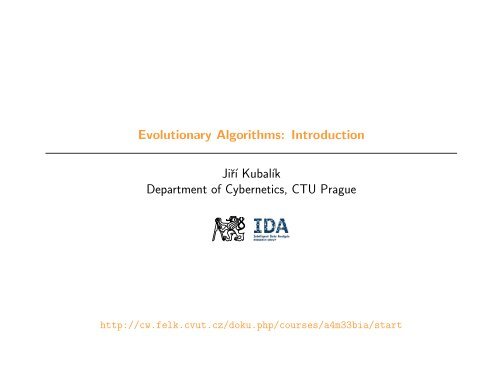

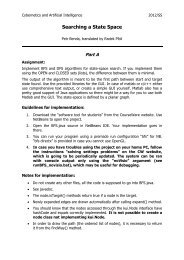
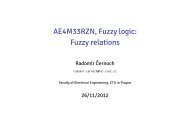


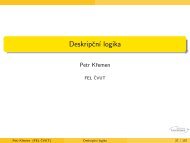


![RANSAC [Fischler, Bolles '81]](https://img.yumpu.com/17549294/1/190x143/ransac-fischler-bolles-81.jpg?quality=85)
